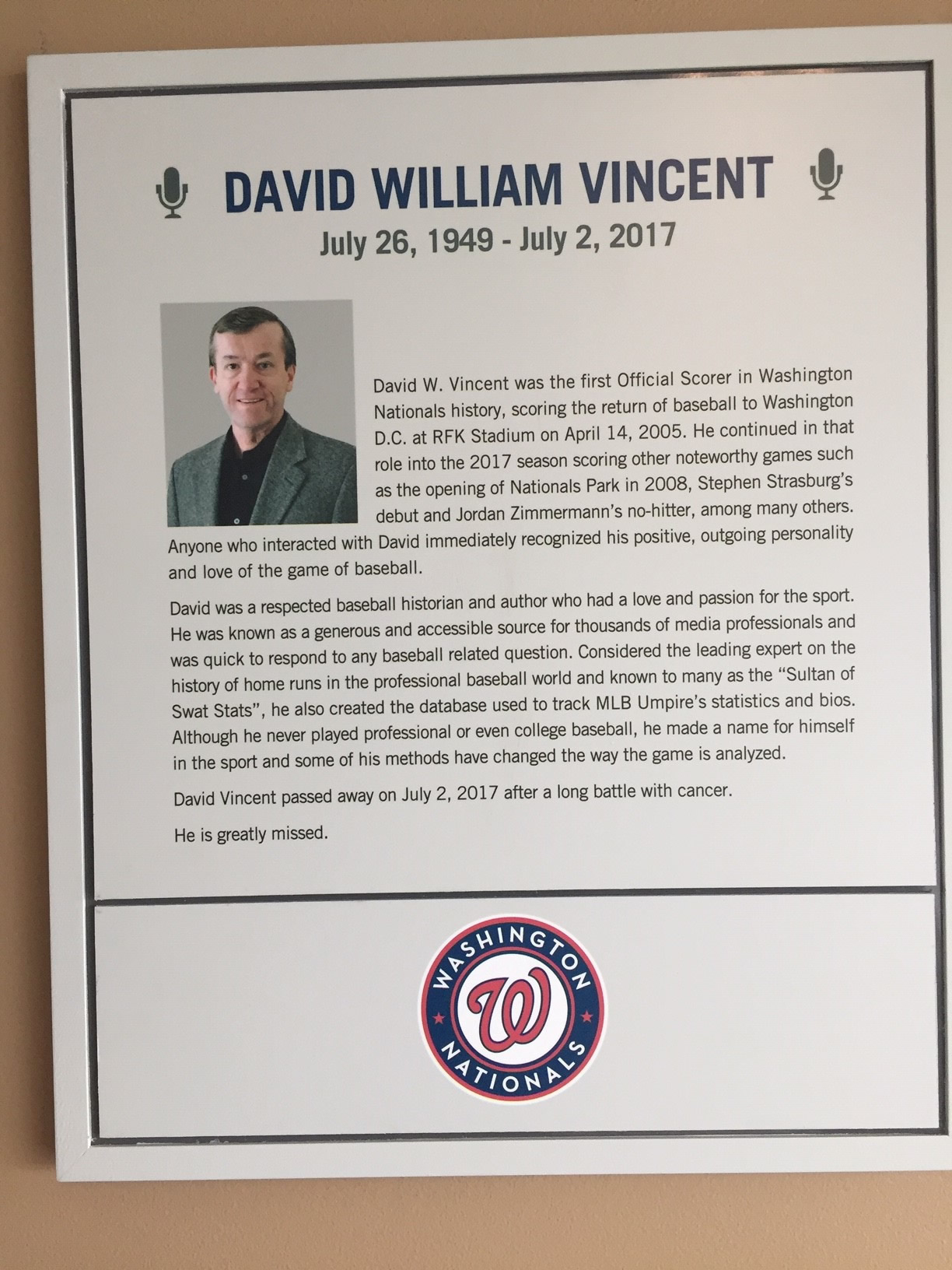SABR Official Scoring Committee: November 2018 newsletter
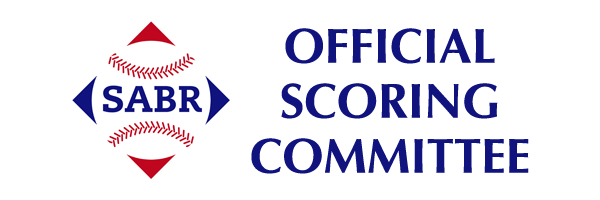
“You Called That a What . . . ?”
The Newsletter of the Official Scoring Committee
Society for American Baseball Research (SABR)
November 2018, Volume 4, Number 1
Editor:
Stew Thornley
- From the Chair
- Conundrum of the Month (or Quarter or Whatever)
- Meet Sven Muencheberg
- Profile: Pat Thompson
- 9.17
- From 1944
- Conundrum Solution
- Honchos
From the Chair
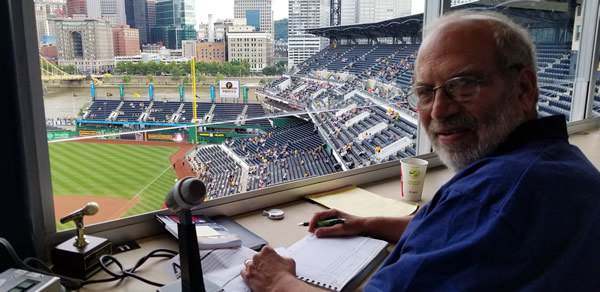 More than 50 members attended June 21 meeting of the Official Scoring Committee, conducted by Bill Nowlin and Marlene Vogelsang, at the Pittsburgh SABR convention. Guests were Pirates official scorers Bob Webb and Evan Pattak (pictured at right), who was the scorer for the 13-inning SABR game, an active game (each team scored an unearned run in the 11th).
More than 50 members attended June 21 meeting of the Official Scoring Committee, conducted by Bill Nowlin and Marlene Vogelsang, at the Pittsburgh SABR convention. Guests were Pirates official scorers Bob Webb and Evan Pattak (pictured at right), who was the scorer for the 13-inning SABR game, an active game (each team scored an unearned run in the 11th).
Recording of Official Scoring Committee Meeting with Bob Webb and Evan Pattak
In Other News:
The Washington Nationals now have a plaque in their press box in memory of David Vincent:
I had a chance to meet Thom Hinton on June 29, 2018 at a Binghamton at Portland (Maine) game. He’s the good-looking one in the photo below.
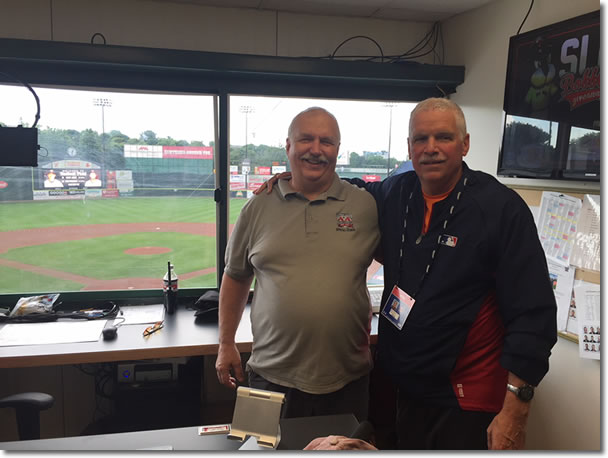
It was Thom’s 1,100th game as an official scorer, and he was flawless as Tim Tebow, who helped Binghamton beat the Sea Dogs 3-2.
As usual, keep an eye on our Committee Files page, as the information in there continues to grow, including:
- Official Scorers Consider Bad hops, Bad Throws—and Exit Velocity
- Knowing the Score—and a Whole Lot More
Sarah Johnson provided links to a number of stories about official scoring that are available through the Los Angeles Times database:
- Hit or Error?: A Question of Judgment : Fans and Players Don’t Really Notice Official Scorers—Until Controversy Arises Over One of Their Decisions
- Official Scorer’s Goodby: It’s So Long to Headaches Caused by Job; Farewell to Press Boxes and Cold Shoulders
- The Pressure Is Increasing for Baseball’s Official Scorers
- Officially, Scoring Is Hit or Miss
- Judging THE Judges: Inconsistent Hiring, Training of Baseball’s Official Scorers Revive Charges of Home-Team Bias
Here are a couple recent articles that garnered attention:
- JBJ and what should be baseball’s ‘last error’: Red Sox outfielder had 6-percent catch probability on tough play
- Jackie Bradley Jr. and the Error Rule
The articles did not rip the official scorer, Mark Jacobson, in this August 10, 2018 Boston at Baltimore game. Mark made a good decision in charging Jackie Bradley with an error, even though the Boston center fielder had done a great job in getting to the fly ball hit by Caleb Joseph in the bottom of the third inning. The critcism focused on the concept of an error, similar to Craig Wright’s chapter in The Diamond Appraised 30 years ago.
What the Bradley play really showed was how irrelevant “Catch Probability” is to official scorers. It may be a great tool for determining the range and/or skill of an outfielder, but on fly balls official scorers focus on the position of the outfielder at the point that he and the ball reach the same point. Was the outfielder in control? Was the ball in his range at this point or was he extending, especially if he had to backhand the ball. Bradley was in control with the ball in his range; thus, it’s an error.
Watch this play and decide if you would call a hit or an error.
This was a pretty easy call, right? Error. I received no heat for calling this an error. No doubt, I would have heard about it had I called it a hit. However, when the ball left Upton’s bat, heading for the left-field corner, I remember thinking, “This could be trouble.” However, Santana used his speed to get to the ball. As a result of all that, the catch probability for the play was under 50 percent (49 percent) and would have been rated a 4-star play had he made it.
Official scorers will continue to make decisions on fly balls based on the position and condition of the outfielder when he reaches the ball. Analysts are free to use catch probability and other tools for their own assessments.
This issue of “You Called That a What . . . ?” doesn’t have a guest column, but such columns are always welcome as are interviews and profiles of official scorers. If you’re interested in doing either or both, contact me: Stew Thornley.
Conundrum of the Month (or Quarter or Whatever)
Sometimes the solution to a conundrum is not an answer; rather, it can be, “What are the questions?”
Take this situation: Boomgarden is on third with one out. Rein hits a grounder to the third baseman, Dinkcraft, as Boomgarden breaks for the plate. Dinkcraft comes home with the throw but sails it over the catcher. Boomgarden scores and Rein ends up on second.
Without seeing the play, or at least with not having more detail, you are not expected to supply the answer. What you are being asked is to supply the questions a scorer must ask to reach a decision. Or, what are the options the scorer has for this play?
Meet Sven Muencheberg
 SABR’s Official Scoring Committee is responsible for a new SABR member, Sven Muencheberg, an official scorer in Germany who joined the organization when he discovered the committee. In Sven’s words:
SABR’s Official Scoring Committee is responsible for a new SABR member, Sven Muencheberg, an official scorer in Germany who joined the organization when he discovered the committee. In Sven’s words:
Baseball and softball are minority sports in Germany with roughly 20,000 players, compared to 6 million soccer players. Most Germans have no clue about baseball and even the baseball players often have no clue about scoring. So being an official scorer in Germany, I usually have a hard time explaining to people what my hobby is.
I started to play baseball when I was 18 years old, after being a handball player for 11 years. I was looking for a new sport and got intrigued by baseball when watching an American sports channel on cable TV. I found out that Berlin had a couple of teams and I played baseball for nine seasons from 1990 to 1998. However, the time needs became too big for me, with practice twice a week and a double header each weekend, with travelling distances for away games up to 400 km. And this in parallel to the time needed for a demanding engineering job in the space industry and my girlfriend. So I retired (way too early) at the age of 27 with a homerun in my final game. But I could not leave this great sport, so I became an official scorer. Being an engineer, I enjoy the logic behind scoring and I love working with numbers and preparing the statistics. I quickly acquired the highest scoring license in Germany and when I passed my scoring exam with a 100% mark, the Scoring Director of the German Baseball Federation suggested that I become a scoring instructor and asked me to prepare a new edition of the German textbook on scoring (see photo on title page in attachment).
Now, 20 years later, I have scored more than 350 games and I have worked as an official scorer in five European championships and the Baseball World Cup 2009, doing scoring on paper or on a PC with The Automated Scorebook. I have prepared three editions of the German Scoring textbook, and one edition of a scoring exercise book. I am assistant editor of the German baseball rulebook (responsible for the translation of Rule 9 into German) and I have written a handbook on baseball statistics. Furthermore I have educated more than 250 scorers in exam courses and refresher courses. I am providing information to more than a thousand German scorers through mailing lists, a scoring website, and a Facebook page on official scoring.
I have been in contact with David Vincent a few years ago and I had the pleasure to sit next to Jordan Sprechman during the WBC Qualifier in Germany in 2013. My dream is to be a scorer at the Olympics 2020, but my chances are slim. However, I will participate in my sixth European championship in 2019, when Germany will be hosting.
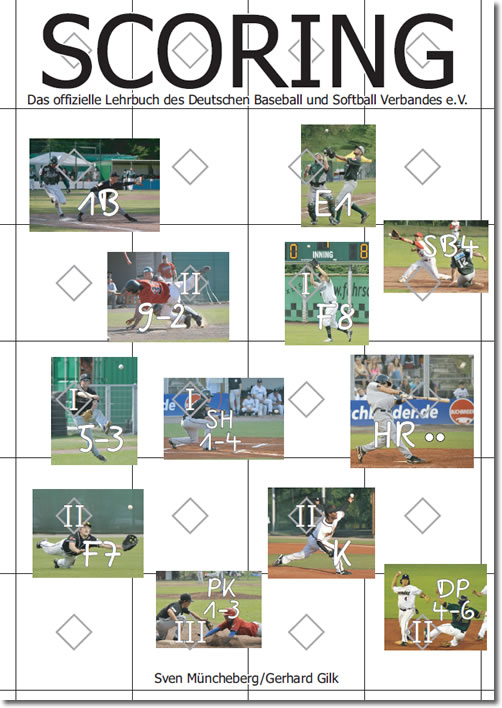
For those who can read German, here are links to the textbook and exercise book (text shown above):
Sven says, “Probably you will not understand the German texts, but as I consider scoring a universal language like math or music, you will probably understand a lot of the contents. Any comments from your side are welcome, especially on the exercises. I am curious whether you agree with all the solutions for the exercises on earned runs, run assignment to pitchers and win/loss/save.”
Profile: Pat Thompson
Pat Thompson stopped by the press box at Target Field in Minneapolis during the 2018 season and introduced himself to the official scorer, a job he performed on occasion for Minnesota Twins games at Metropolitan Stadium while working for the St. Paul Pioneer Press-Dispatch in the 1970s. One observation Pat had of his visit was, “I found the press box much too quiet, almost spooky — everyone absorbed in their tablets. We seemed to be much more gregarious and convivial.”
Asked to share more of his experiences of those days, Pat wrote after the season:
Memory from those days is a little hazy, but it was a priceless moment in time for me.
We had quite the closeknit sports writing crew at the St. Paul Pioneer Press-Dispatch, a bunch of young writers who were very close at work and at play. We’d play touch football and softball and enjoy beating the socks off the [Minneapolis] Tribune (pre-Strib) in games that featured a lot of verbal rhubarbs. How would you like to have an offensive line of Big Shooter Walters, Gary Olson and Charley Hallman, all huge guys. Huge, but slow. Wonger [Gregg Wong] was the quarterback and always distributed the passes to everyone.
Back to baseball. Several BBWAA writers from St. Paul served as official scorers: Arno Goethel, Glenn Redmond, Mike Augustin, Patrick Reusse and myself, plus guys like Bob Fowler of the [Minneapolis] Star and Tom Briere of the Tribune.
At times, we covered games and scored at the same time. It never was an issue for us. Going into the clubhouses for quotes provided an opportunity to confirm a ruling if you had second thoughts. [Manager] Frank Quilici was always a good resource if you thought you needed an opinion on changing a call. [Twins public-relations director] Tom Mee was the lynchpin; he never urged you to change a call or tell you that you might have blown a ruling.
I know players were quite vehement, at times, when they didn’t agree with rulings. I don’t recall any of these instances, personally, but I witnessed players challenging other scorers. It had no effect on my coverage.
Fortunately, I wasn’t scoring the time Ralph Houk verbally and almost physically ran me out of the Yankee clubhouse in 1969 when I was a 27-year-old rookie writer with the Associated Press. Twins pitcher Dave Boswell was forced to leave a game in the late innings when he was struck by a pitch while batting. He accussed the Yankees of purposely throwing at him to get him out of the game. When I asked Houk about it, he exploded and evicted me from the clubhouse with the Yankees laughing their butts off as I was escorted to the door at old Met Stadium. The next day, I apologized to the Major and, he in turn, apologized to me and said [Twins manager] Billy Martin had interceded with a positive recommendation of my character. Twins like Jim Kaat greeted me with chuckles. Jim Klobuchar wrote a column on me, referring to me as Clark Kent of the AP, where I worked at the Minneapolis bureau from 1968-1974. I joined the Pioneer Press April 1, 1974.
The only dispute I had in the short time I served as the official scorer, involved Hall of Fame pitcher Jim Palmer of the Baltimore Orioles. I ruled a hit on a scorching grounder to deep short (Mark Belanger must have been the SS). Palmer called the press box and requested the ruling be changed to an error. A couple of runs scored in the inning and Palmer was bidding to become the American League ERA champion. I refused to change the ruling after talking with several persons in both clubhouses. Tom Mee, who had agreed with my ruling, told me later that Palmer appealed to the American League, but the ruling was upheld. Sorry I cannot remember the year, or the date.
Serving as the official scorer did not detract from doing my job as a writer, probably enhanced it in becoming more aware of the finer aspects of the game. What was burdensome was filling out the triplicate boxscore carbons. I felt a lot of pressure in making sure everthing was perfect. I noticed you were using a computerized scoresheet—what a dream. I can remember my scorebooks looked like a chicken had walked and pecked its way through my pages. (I still use a BBWAA book for my senior teams).
Note: Pat added that he was disappointed during his 2018 visit that 98-year-old Sid Hartman, still a columnist for the Minneapolis paper, was not there; “I was disappointed not to see Sid, who used to call me Mr. Scoop. ‘The Major was right to run you out of the clubhouse, ’ he would remind me.”
9.17(c)
From the editor: Official scorers often have to assign a win to a reliever when a starting pitcher does not go five innings but leaves with a lead that his team holds. Less frequent is the application of Rule 9.17(c), to wit:
The official scorer shall not credit as the winning pitcher a relief pitcher who is ineffective in a brief appearance, when at least one succeeding relief pitcher pitches effectively in helping his team maintain its lead. In such a case, the official scorer shall credit as the winning pitcher the succeeding relief pitcher who was most effective, in the judgment of the official scorer.
Rule 9.17(c) Comment: The official scorer generally should, but is not required to, consider the appearance of a relief pitcher to be ineffective and brief if such relief pitcher pitches less than one inning and allows two or more earned runs to score (even if such runs are charged to a previous pitcher).
Up until this season, I had only attended one professional game (out of about 2,500) that this occurred: July 11, 1975, Los Angeles at St. Louis. However, I was able to apply this rule in a game when I was official scorer on July 14, Tampa Bay at Minnesota.
Adam Kolarek relieved Diego Castillo to start the last of the sixth, with Tampa Bay ahead 4-2. The Twins scored four off Kolarek, who pitched the full inning and became the pitcher of record when the Rays scored five runs in the top of the seventh on their way to a 19-6 win. Jaime Schultz started the last of the seventh and pitched 2-2/3 innings, allowing three walks and no runs. Schultz was credited with the pitching victory, his first in the majors, as Kolarek’s performance was deemed brief and ineffective.
After the game, @TwinsRadio posted on its Twitter account: Finally, Adam Kolarek not credited with the win despite being pitcher of record when his team took the lead…HAD he gotten the win, he would’ve become just the 5th player in MLB history to get the ‘W’ despite pitching just 1 in, surrendering 4+ R and 5+ hits. (last in AUG ‘04)
Here are the other instances of pitchers meeting the above criteria:
- Jack Knott, St. Louis Browns at home vs. Philadelphia Athletics, May 22, 1934—Game was tied 6-6 when Knott entered in the top of the ninth and gave up 5 runs (all earned) and 5 hits in 1 inning. The Browns scored six runs in the last of the ninth for a 12-11 win.
- Bruce Ruffin, Colorado Rockies at home vs. New York Mets, June 7, 1994—Colorado led 8-4 when Ruffin entered the game in the top of the eighth. He gave up 4 runs (all earned) and 5 hits in 1 inning. The Rockies scored 2 in the last of the eighth for a 10-8 win. Mike Munoz pitched the top of the ninth and got the save (his only save of the season).
- Mike Williams, Pittsburgh at Colorado, August 31, 1999—Pittsburgh led 8-4 when Williams entered in the bottom of the ninth. He gave up 4 runs (all earned) and 6 hits in 1 inning. Pittsburgh scored a run in the top of the 10th. Jose Silva pitched the bottom of the 10th and got the save as Dante Bichette was thrown out at the plate to end the game as he tried to score the tying run on a double by Vinny Castilla.
- Jose Mesa, Pittsburgh at Arizona, August 16, 2004—Pittsburgh led 7-3 when Mesa entered in the bottom of the ninth. He gave up 4 runs (all earned) and 5 hits in 1 inning. Pittsburgh scored a run in the top of the 10th. Mike Gonzalez pitched the bottom of the 10th and got the save (his only save of the season).
In Knott’s case, he was the last pitcher, so the win could not have gone to anyone else (and I’m not sure if the rule regarding brief and ineffective existed then). In the other situations, another pitcher got the save. That pitcher could have received the win instead of the brief and ineffective pitcher, but the scorer chose to stick with the win for that pitcher and give the save to the final pitcher.
How often is Rule 9.17(c) — formerly 10.19(c)(4) and 10.16(b)(5) — applied? A query to SABR-L didn’t turn up an exhaustive list, but Gerry Myerson and Steve Hatcher came up with other examples of its application:
July 21, 1963 Los Angeles at Milwaukee
June 21, 1972 Baltimore at California
May 9, 2004 Cleveland at Baltimore
April 13, 2006 Baltimore at Tampa Bay
September 12, 2013 New York Yankees at Baltimore
July 17, 2017 Toronto at Boston
From 1944
Found in the 1945 Official Baseball Guide, p. 239:
“HONEST” WHITEY WIETELMANN
If Whitey Wietelmann, Boston Brave shortstop, becomes known as “Honest” among his teammates, there’s a reason. On June 29 in a night-game with the Reds, Frank McCormick hit a hard grounder to third which was fumbled by the Brave third baseman Phillips. The ball went out into left field and the throw-in came wide to second base. Tom Swope, official scorer, immediately called the error against the Boston left fielder, Ab Wright. Not a voice was raised in protest in the press box. However Swope wasne’t so sure and the next day approached Whitey and asked him who had made the throw. “I threw it,” said Wietelmann. An erasure in the records, the changing of some figures, and hence the nickname “Honest.”
NOTE: According to Retrosheet, this game was played as the second game of a doubleheader on June 28 (not June 29, as the blurb states). The play occurred in the bottom of the sixth inning with Max Marshall on third. Third-baseman Dee Phillips was charged with an error for muffing McCormick’s grounder. Wietelmann’s errant throw allowed Marshall to score and McCormick to take second.
Conundrum Solution
Obviously, there has to be an error on this play since Rein reached second. But is it an advancement error only, or is it for both missing the out at the plate and for allowing Rein to get an additional base?
Is there a run batted in?
Is Boomgarden’s run earned?
The options the scorer has are these:
Fielder’s choice, no RBI, run is unearned. This would be the case if the scorer believed that Dinkcraft, with ordinary effort, could have been able to put out Boomgarden at the plate. This can be a tricky determination since the play requires a tag, but if the scorer believes a good throw would have arrived at the plate with plenty of time for the catcher to make the tag, this would be an appropriate decision. In this case the error would have two effects: failure to put out Boomgarden and allowing Rein to get to second.
Fielder’s choice, RBI, run is earned. In this case, the scorer decided that it was uncertain if even a good throw could have retired Boomgarden. Thus, the effect of the error is only for allowing Rein to advance to second.
Hit, RBI, run is earned. If the ball were softly hit and the scorer determined that Dinkcraft’s only chance at an out was at the plate, it would be appropriate to credit Rein with a hit and RBI; the error would be for allowing Rein to advance to second.
Official scorers have to do more than come up with answers. Sometimes they first have to determine the questions.
Honchos
Stew Thornley—(Chair and Newsletter Editor)
Marlene Vogelsang—(Vice Chair)
Gabriel Schechter—(Vice Chair)
Bill Nowlin—(Vice Chair)
Sarah Johnson—(Vice Chair)
John McMurray—(Vice Chair and Liaison to the Oral History Research Committee)
Art Mugalian—(Assistant to the Traveling Secretary)



